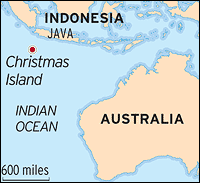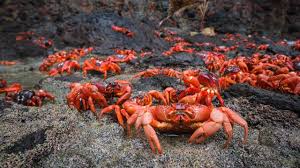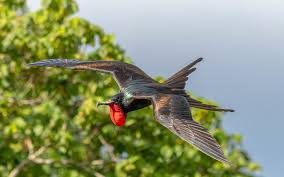We all have past Christmas stories and this year we will have the chance to make new stories. Although I am grateful for many heartwarming Christmas’s past I am choosing to write about a Christmas subject I knew nothing about until the last few days.
That is – Christmas Island and a couple of it’s inhabitants. That’s no ho-ho-ho. It’s a real place in the Indian Ocean, between Australia and Indonesia. Although closer to Indonesia it is owned by Australia. And get this – 63 % of the 135 km (33,359 acres) area is a national park, famous for its caves and coral reefs. The population of the small dog shaped island is about the size of my hometown – 1843 people. Why is it named Christmas Island? Well, because an English sea captain named it on Christmas Day. I may be wrong, but I’m thinking English sea captains may be lacking when it comes to imaginative skills – at least this particular one.
But, I suppose you could say the English sea captain was a “naming” pioneer of sorts as the fellas that named the Christmas Island Red Crab and the Christmas Frigate Bird obviously followed in his footsteps. Can you imagine these three men, sitting around a small round table in a pub somewhere in Flying Fish Cove (the capital of Christmas Island) and feeding off of each other’s lack of ingenuity?
On the other hand, maybe these critters aren’t so wrongly named as this crab is endemic to Christmas Island and the Christmas frigate bird only breeds on this particular island. As amazing as that is in itself, each specimen has other special qualities.
The Christmas Island Red Crab makes the same migratory trek each year to the sea – climbing over whatever is in it’s path. The park service personnel do their best to keep them manually swept off the roadways, but it’s no easy task to keep the estimated 150 million crustaceans viable. The purpose of reaching the sea is to take a dip which replenishes the’ crab’s body moisture and salts. Once the males are satisfied that their bodies have been reconditioned, they return to the shore and dig burrows for mating. The females, unlike the males, do not make the trek back but stay put to bear their young. Before the males start their journey back from where they came they dip one more time.
The Christmas Frigate Bird is a large seabird with a wing span of 7.1 feet. Unlike other seabirds, it’s feathers are not waterproof. I found this to be a bit dis-concerning. What happens to a poor seabird if he doesn’t have feathers that repel water? No worries – God made them masters of staying aloft – for as long as 10 days. They feed primarily on flying fish, tuna, herring, and squid which they grab from the surface without getting wet. And if, on a certain day, the fish just aren’t to be found, they resort to harassing other birds to the point of indigestion and regurgitating. Maybe not as good as fresh, but it will do!
I realize this hasn’t been the typical Christmas story, but on the other hand, maybe it’s not so atypical either. We’ve learned about some of God’s magnificent creations and gifts he’s given us through nature. His greatest gift, however, was given to humankind in the form of a baby in a manger, 2000 years ago on a Christmas night.
For God so loved the world, that He gave His one and only Son, that whoever believes in Him shall not perish but have eternal life. John 3:16. If you’ve not yet accepted this free gift, you can make it your story this Christmas.



Until next month, keep on readin’ and I’ll keep on writin’.
